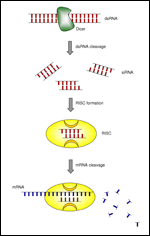RNAi-Based Therapies for Cancer in Development
After the initial excitement over the potential of RNAi to target any cancer gene, the field is now being viewed with caution and a bit of skepticism. Delivery system issues need to be solved and substantial clinical data of patient responses from early-stage trials need to be shown for the field to look promising.
Last November, Roche announced that it was cutting out its RNA interference (RNAi) therapeutic development program, stating that the science was not a good strategic fit for the company because of the major specific drug-delivery hurdle. In February, Pfizer announced discontinuing its RNA R&D as part of a cost-saving restructuring plan, making it seem as if the technology development is a fruitless endeavor. After the initial excitement over the potential of RNAi to target any cancer gene, the field is now being viewed with caution and a bit of skepticism. Delivery system issues need to be solved and substantial clinical data of patient responses from early-stage trials need to be shown for the field to look promising.
The Journal of Clinical Oncology recently published an overview of RNAi interference-based therapies, including a thorough background on the mechanism of RNAi in human cells, the dysregulation of this pathway in specific cancers, and the caveats to this technology (DOI: 10.1200/JCO.2009.27.6287).

Mechanism of RNA interference (RNAi). Source: Simone Mocellin and Maurizio Provenzano, Wikimedia Commons
RNAi is the silencing of gene expression that is triggered by the presence of short 22-mer double-stranded (ds) RNAs homologous to a portion of a gene. With the help of protein complexes and enzymes in the cell, the messenger RNA (mRNA) of the gene is either cleaved and degraded or translation of the mRNA is blocked. RNAi was first linked to cancer by genetic studies in chronic myeloid leukemia (CLL) and recent studies show that the process is dysregulated in cancer cells.
The RNAi machinery found in cells can be harnessed to specifically knock down gene expression by the introduction of synthetic short dsRNAs called small interfering RNAs (siRNAs). Because any siRNAs can be designed and synthesized, they can be made to target any gene, allowing any cancer gene to become a therapeutic target, in theory. However, the list of caveats is long for now, and includes delivery system hurdles, short duration of gene silencing with a single dose, and off-target suppression. So far, the two types of tissue that can be targeted well are the liver and mucosal surfaces or body cavities.
Currently, there are 5 cancer clinical trials, all in Phase I, using RNA interference, evaluating the initial safety and utility of these treatments.
Calando Pharmaceuticals is using nanoparticles to deliver siRNA against a protein essential for DNA replication to treat solid tumor cancers. It is the first siRNA trial using a targeted nanoparticle delivery system. The agent, CALAA-01, contains siRNAs against the RRM2 gene. A recent paper on CALAA-01 9i(Nature. 2010 April 15; 464(7291): 1067–1070) demonstrated gene-specific inhibition via RNAi within tumors in 3 patients.
Alnylam Pharmaceuticals also has an RNAi therapeutic, ALN-VSP02, for solid tumors involving the liver that uses a lipid nanoparticle delivery system with two siRNAs targeted against the vascular endothelial growth factor (VEGF) and kinesin spindle protein (KSP). The rationale is that having 2 cancer gene targets will potentially increase therapeutic impact. Preliminary data from 28 patients showed a general tolerability, although 2 patients had dose-limiting toxicity. Updated results are expected at the 2011 ASCO meeting.
A company based in Israel, Silenseed, Ltd, has an entity for adenocarcinoma of the pancreas. The agent is called siG12D LODER and consists of a miniature biodegradable polymer matrix that encloses KRAS RNA that targets the KRAS protein with the G12D mutation that is commonly mutated in pancreas. The treatment is designed to release the drug regionally within the pancreatic tumor for up to eight weeks.
A fourth company, Silence Therapeutics AG, has a liposomal siRNA formulation, Atu027, against PKN3, a protein kinase involved in metastatic motility. The treatment appears to be the farthest along in development and has the most pre-clinical data published on its mechanism and utility. The treatment is aimed at gastrointestinal, lung, and other advanced solid tumors. Animal cancer model results, showing its ability to prevent metastasis to the lungs, were published in November 2010 (Clin Cancer Res November 15, 2010 16; 5469). The company also presented data in February 2011 on its Phase I trial, 157 doses administered to 20 patients with no signs of dose-escalating toxicity. One patient was reported to have tumor shrinkage while several patients had stable disease over the 3-month study period.
EZN-2968, developed by Sataris Pharma and Enzon Pharmaceuticals, targets hypoxia-induced factor (HIF-1) and Survivin, an apoptotic protein. A Phase I dose-escalation trial evaluating the treatment of advanced solid cancers with liver metastases in collaboration with the National Cancer Institute is ongoing. So far, the therapy is well tolerated and no dose-limiting toxicity has been detected in patients with advanced solid tumors and lymphoma. The treatment is using a locked nucleic acid (LNA) based approach for delivery that has the potential for oral delivery in the future.
There has been progress over the last 4 years in terms of different delivery system technology and the movement of RNAi therapeutics from pre-clinical into human trials. With the first substantial patient data from these RNAi-based therapies on the near-term horizon, and new studies likely to begin soon, it is too early to dismiss RNAi therapeutics for cancer treatment.